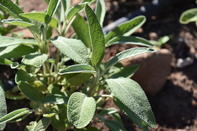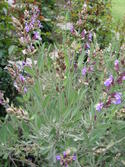
Yield - Tonnes per hectare per year
Conservative
Fresh: 6 tonnes
Dry: 1 tonnes
Oil: 50 to 60 litres
Average
Fresh: 8 tonnes
Dry: 3 tonnes
Oil: 80 to 100 litres
Good
Fresh: 12 tonnes+
Dry: 4 tonnes+
Oil: 150 litres+
Harvesting

Harvesting of most large commercial sage operations is done by mechanically mowing 20 cm of the tips of the branches. On smaller production units and in greenhouses it is done by hand using a sharp knife or shears.
Harvesting of the fresh tips can start as early as 12 weeks after planting seedlings or established cuttings. Harvesting must occur before the plant goes into flower as this is when the essential oil levels are at their highest.
Fresh production: start harvesting the leaves early in the morning when the temperature is still cool but dew on the leaves has dried. Cut off the top 20 cm of the growth points.
Dry production: For dried sage production, cutting can be started as soon as there are enough leaves to be harvested. Most of the vegetative growth is trimmed before flowering commences. The leaves are separated from the stalks and then dried at about 40°C using forced air driers.
Essential oil production: The best essential oils come from distilling just the leaves of the sage plant using the steam distillation process.
Storage
Fresh production: After harvesting store fresh sage at 1 to 2°C. The sage can be stored for about 2 weeks. The relative humidity in storage should be kept above 95%. Sage starts losing its flavour from the volatile oils after harvest so it is best to market and use fresh cut sage as soon as possible.
Dry production: The dried leaves are packaged in airtight containers as soon as possible so they retain their colour and flavour. Keep at about 10°C and out of direct light. Dry Sage can also be stored frozen in airtight containers.
Essential oil: Store bottled sage essential oils in a dry dark and cool space for about a year to 18 months after bottling. After this, the oils start to lose their potency and odour.
Crop Protection
Weeds are a problem and these have to be monitored and weeding whether mechanically, by hand or with herbicides must be done continuously throughout the year.
A good method of combating weeds is to mulch with either plastic mulching or with vegetative ground cover like wood chips. High-density plantings help to overshadow the ground thereby stopping weeds germinating. Any tilling of the soil around the plant promotes weed emergence so this should be kept to the minimum.
Sage, like most of the high oil producing herbs with strong aromas, has few pests and diseases but it is best to follow a crop protection regime prescribed by an extension officer or agronomist.
The local chemical salesmen generally have the right programs or could provide information as to the best advisors available in close proximity to the production area. Some common pests and diseases are listed below.
Pests
Aphids, Crown gall, Scale, Spider mite, Thrips and White fly are common pests.
Diseases
Bacterial rot, Leaf spot, Powdery mildew, Root rots and Rust.